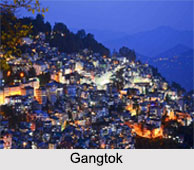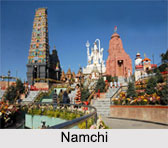 Cities of Sikkim lie in the lap of the eastern Himalayan mountain ranges forming the hill stations. Herein lies Mount Khanchendzonga (8534 mts), the third highest mountain in the world. The cities are placed in a network of mountain peaks, lush valleys, fast flowing rivers and hills. Cities of Sikkim with all their grandeur provide a perfect place for tourists to experience a warm ambience.
Cities of Sikkim lie in the lap of the eastern Himalayan mountain ranges forming the hill stations. Herein lies Mount Khanchendzonga (8534 mts), the third highest mountain in the world. The cities are placed in a network of mountain peaks, lush valleys, fast flowing rivers and hills. Cities of Sikkim with all their grandeur provide a perfect place for tourists to experience a warm ambience.
Cities of Sikkim offer such contrast that within a few hours one can shift from the sub tropical heat of the lower valleys to the cold of the rugged mountain slopes that reach up to the region of everlasting snow. Different festivals celebrated in the cities are the Hindu festivals of Diwali and Dussera and the common Buddhist festivals of Losar, Loosong, Saga Dawa, Lhabab Duechen, Drupka Teshi and Bhumchu. The major cities of Sikkim areGangtok (the capital city), Pelling, Gezing, Mangan, Namchi and Yuksan.
Pelling
Pelling is a town in the district of West Sikkim. Pelling is nestled at an altitude of 2,150 m (7,200 feet). The town is located at a distance of 10 km from the district headquarters of Geyzing.
Yuksom
Yuksom is a historical town in West Sikkim district of Sikkim. It was the first capital of Sikkim established in 1642 by Phuntsog Namgyal who was the first Chogyal of Sikkim.
Rangpo
Rangpo is a town in East Sikkim. The town borders West Bengal and is situated along the Teesta River. It is the first town in Sikkim on NH 10 that links Siliguri to Gangtok
Gangtok
Gangtok is one of the most trendy traveller destinations in Sikkim. It is the capital and largest city in the state. It is located in the Shivalik Hills on the eastern part of the Great Himalayas. Gangtok is located at an elevation of 1,437 meters (4,715 ft).
Ghezing
 Gyalshing or Gezing is the capital of the district of West Sikkim in Sikkim. The town is connected to the capital Gangtok by a metalled road. Gezing is also connected to the West Bengal towns of Darjeeling and Kalimpongvia Jorethang. A few kilometres north is the town of Pelling. The town has a large Nepali population and the Nepali language is the predominant language of the region. The town is situated at an altitude of about 6500 feet (1900 m). The town enjoys a temperate climate for most of the year and snow sometimes falls in the vicinity.
Gyalshing or Gezing is the capital of the district of West Sikkim in Sikkim. The town is connected to the capital Gangtok by a metalled road. Gezing is also connected to the West Bengal towns of Darjeeling and Kalimpongvia Jorethang. A few kilometres north is the town of Pelling. The town has a large Nepali population and the Nepali language is the predominant language of the region. The town is situated at an altitude of about 6500 feet (1900 m). The town enjoys a temperate climate for most of the year and snow sometimes falls in the vicinity.
Mangan
Mangan is the district headquarters of North Sikkim, a little hamlet with flower patches, and the water wheels strung with bells set in exquisite miniature gardens more than compensate for the primitiveness of the region. Mangan Bazaar (market place) is situated on the North Sikkim highway with around fifty odd shops. The District Collectorate where the district collector and other government department function is situated around two kilometres uphill from market at a place called Pentok and is approached by a link road. On the sides of this link road while travelling towards Pentok lies a public ground and Mangan Senior Secondary School. Just opposite to Mangan, separated by Teesta River, is seen a sloppy villages namely Lingdong, Barfok, Hee-Gyathang falling under Dzongu area. From the Pentok area, the picturesque view of mount Siniolchu (a range of mount Khangchendzonga) is also seen.
Namchi
Namchi nestled among the hills at an elevation of 5,500 ft commands panoramic view of the snow-capped mountains and vast stretches of valley. It is also the headquarters of the South District of Sikkim.
Rabdentse
Rabdentse, the second capital of the earlier kingdom of Sikkim, is located near Pelling, in the district of West Sikkim, in North-eastern state of Sikkim. Rabdentse was the capital of Sikkim from 1670 to 1814, and the city was destroyed the Nepali army, who invaded the kingdom. Currently, only the ruins of the palace and the stupas are present here. Pemayangtse Monastery, one of the oldest monasteries in the state, is located in close proximity to the Rabdentse ruins.



















